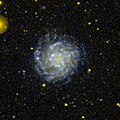NGC 5668 is a nearly face-on spiral galaxy, visual magnitude about 11.5,[4] located about 81[2] million light years away in the constellation Virgo. It was discovered on 29 April 1786 by William Herschel.[4]
NGC 5668 is a member of the NGC 5638 Group of galaxies, itself one of the Virgo III Groups strung out to the east of the Virgo Supercluster of galaxies.[5] In addition, A.M. Garcia listed NGC 5668 in the 31 member NGC 5746 galaxy group (also known as LGG 386).[6]
As seen from the Earth, it is inclined by an angle of 18° to the line of sight along a position angle of 145°. The morphological classification in the De Vaucouleurs system is SA(s)d,[2] indicating a pure spiral structure with loosely wound arms.[7] However, optical images of the galaxy indicate the presence of a weak bar structure spanning an angle of 12″ across the nucleus. There is a dwarf galaxy located around 650×103 ly (200 kpc) to the southeast of NGC 5668, and the two may be gravitationally interacting.[2]
Supernovae
Three supernovae have been observed in this galaxy:
- SN 1952G (type unknown, mag. 17.9) was discovered by Fritz Zwicky on 18 April 1952.[8][9]
- SN 1954B (type Ia, mag. 12.3) was discovered by Paul Wild on 4 May 1954.[10] [Note: Some sources incorrectly list the discovery date as 27 April 1954.][11]
- SN 2004G (type II, mag. 17.2) was discovered by Reiki Kushida on 19 January 2004.[12][13][14] It was initially imaged at 43" to the west and 12".5 south of the galaxy core.[13]
High velocity clouds of neutral hydrogen have been observed in NGC 5668, which may have their origin in supernova explosions and strong stellar winds.[15]
Gallery
-
NGC 5668 (SDSS DR14)
-
GALEX image of NGC 5668
See also
References
- ^ a b Skrutskie, Michael F.; Cutri, Roc M.; Stiening, Rae; Weinberg, Martin D.; Schneider, Stephen E.; Carpenter, John M.; Beichman, Charles A.; Capps, Richard W.; Chester, Thomas; Elias, Jonathan H.; Huchra, John P.; Liebert, James W.; Lonsdale, Carol J.; Monet, David G.; Price, Stephan; Seitzer, Patrick; Jarrett, Thomas H.; Kirkpatrick, J. Davy; Gizis, John E.; Howard, Elizabeth V.; Evans, Tracey E.; Fowler, John W.; Fullmer, Linda; Hurt, Robert L.; Light, Robert M.; Kopan, Eugene L.; Marsh, Kenneth A.; McCallon, Howard L.; Tam, Robert; Van Dyk, Schuyler D.; Wheelock, Sherry L. (1 February 2006). "The Two Micron All Sky Survey (2MASS)". The Astronomical Journal. 131 (2): 1163–1183. Bibcode:2006AJ....131.1163S. doi:10.1086/498708. ISSN 0004-6256. S2CID 18913331.
- ^ a b c d e f g R. A., Marino; et al. (July 2012), "Integral Field Spectroscopy and Multi-wavelength Imaging of the nearby Spiral Galaxy NGC 5668: An Unusual Flattening in Metallicity Gradient", The Astrophysical Journal, 754 (1): 61, arXiv:1205.5051, Bibcode:2012ApJ...754...61M, doi:10.1088/0004-637X/754/1/61, S2CID 2243509.
- ^ "NGC 5668 -- Galaxy", SIMBAD Astronomical Database, Centre de Données astronomiques de Strasbourg, retrieved 2013-07-11.
- ^ a b "New General Catalog Objects: NGC 5650 - 5699". cseligman.com. Retrieved 2021-03-12.
- ^ "The Virgo III Groups". Atlas of the Universe. Retrieved 2010-11-27.
- ^ Garcia, A. M. (1993). "General study of group membership. II. Determination of nearby groups". Astronomy and Astrophysics Supplement Series. 100: 47. Bibcode:1993A&AS..100...47G.
- ^ Buta, Ronald J.; et al. (2007), Atlas of Galaxies, Cambridge University Press, pp. 13–17, ISBN 978-0521820486.
- ^ "SN 1952G". Transient Name Server. IAU. Retrieved 7 September 2024.
- ^ Kowal, C. T.; Zwicky, F.; Sargent, W. L. W.; Searle, L. (1974). "The 1973 Palomar Supernova Search". Publications of the Astronomical Society of the Pacific. 86 (512): 516. Bibcode:1974PASP...86..516K. doi:10.1086/129639.
- ^ Wild, Paul (1960). "Light Curves of the Supernovae of 1954". Publications of the Astronomical Society of the Pacific. 72 (425): 97. Bibcode:1960PASP...72...97W. doi:10.1086/127488.
- ^ "SN 1954B". Transient Name Server. IAU. Retrieved 7 September 2024.
- ^ "SN 2004G". Transient Name Server. IAU. Retrieved 7 September 2024.
- ^ a b Nakano, S.; et al. (2004), "Supernova 2004G in NGC 5668", IAU Circular, 8272: 1, Bibcode:2004IAUC.8272....1N.
- ^ Elias-Rosa, N.; et al. (2004), "Supernova 2004G in NGC 5668", IAU Circular, 8273: 2, Bibcode:2004IAUC.8273....2E.
- ^ Jiménez-Vicente, J.; Battaner, E. (June 2000), "Vertical motions in the disk of NGC 5668 as seen with optical Fabry-Perot spectroscopy", Astronomy and Astrophysics, 358: 812–818, arXiv:astro-ph/0004295, Bibcode:2000A&A...358..812J.
External links
 Media related to NGC 5668 at Wikimedia Commons
Media related to NGC 5668 at Wikimedia Commons











You must be logged in to post a comment.